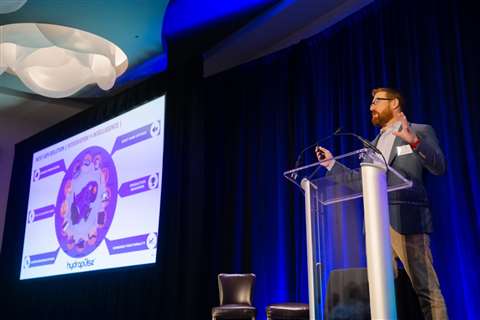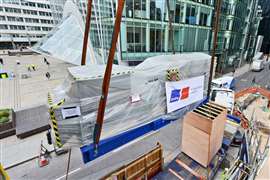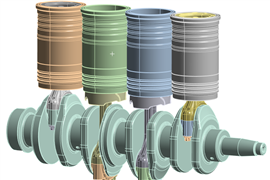Terzo drives shift in hydraulic system architecture
06 October 2022
 Mike Terzo, speaking to attendees of the 2022 Diesel Progress Summit. (Photo: KHL/Joe Mather)
Mike Terzo, speaking to attendees of the 2022 Diesel Progress Summit. (Photo: KHL/Joe Mather)
When it comes to off-highway equipment, hydraulic systems are notoriously inefficient, Mike Terzo said in a presentation at the Diesel Progress Summit.
“In conventional hydraulics systems, we use a really big variable volume pump and distribute that fluid power out to a whole bunch of valves,” said Terzo, CEO and founder of Terzo Power Systems, a developer of unique electrohydraulic systems. “And along this process out to the work function, we lose a lot of energy. Sometimes up to 95% of the energy that we put into that hydraulic system is lost to heat.”
(Shortly after the Summit, Terzo announced he was moving on to a new startup company as CEO of construction technology company Monocerus).
In his Summit presentation, Terzo discussed how Terzo Power Systems’ Hydrapulse electric hydraulic technology can help to address the challenges of energy loss in hydraulics by integrating “intelligence” into the system. “We integrate pressure transducers and we close the loop on board,” he said. “We control hydraulics digitally, and this gives us a very power technology to use as a basis of deploying into the mobile space.
“We basically bypass all the valves, all of the pump losses and a whole bunch of other stuff and we have a really, really energy efficient system.”
An architectural shift
Electrification of hydraulics represents a “a fundamental shift in the architecture of the hydraulic system of off-highway equipment,” said Terzo. “Off-highway equipment is very heavily dependent on hydraulics. And the more hydraulically dependent you are on a vehicle platform, the better use case it is for electrification because we get to address that energy efficiency problem and we get a lot of bang for the buck.”
Electrohydraulic power on demand, or a distributed pump system, dedicates a single pump to a specific work function. “That allows us to get rid of almost all of the components on a vehicle’s hydraulic system that loses energy – the valves, the coolers, the pump idling,” said Terzo. “We’ve actually proven and documented with some of our research that we can hit over 96% improvement in energy savings.”
For many applications, the shift to such a system will call for smaller, and smarter, engines. “We need engines that can address the stop-start requirements of a hybrid application, because it’s slightly different [than diesel],” Terzo explained. “We need to be able to control them, we need to be able to integrate them into a thermal management system for a hybrid or battery electric… The thermal management system is all intertwined because we’re pulling heat off the engine and transferring it to the battery pack.”
Clearly, such a complete architectural shift like Terzo described won’t be seamless or simple. But it presents opportunities to address one of the biggest obstacles associated with electrification. “The beauty is you could just add a gen-set onto this architecture and now you can address range issues, you can address remote work,” Terzo said. “We’re not dependent on the battery constraints... We actually see hybrid as the future for off highway, for sure.”
Click here to read more about Terzo’ Hydrapulse electric hydraulic technology.
POWER SOURCING GUIDE
The trusted reference and buyer’s guide for 83 years
The original “desktop search engine,” guiding nearly 10,000 users in more than 90 countries it is the primary reference for specifications and details on all the components that go into engine systems.
Visit Now
STAY CONNECTED




Receive the information you need when you need it through our world-leading magazines, newsletters and daily briefings.
CONNECT WITH THE TEAM













